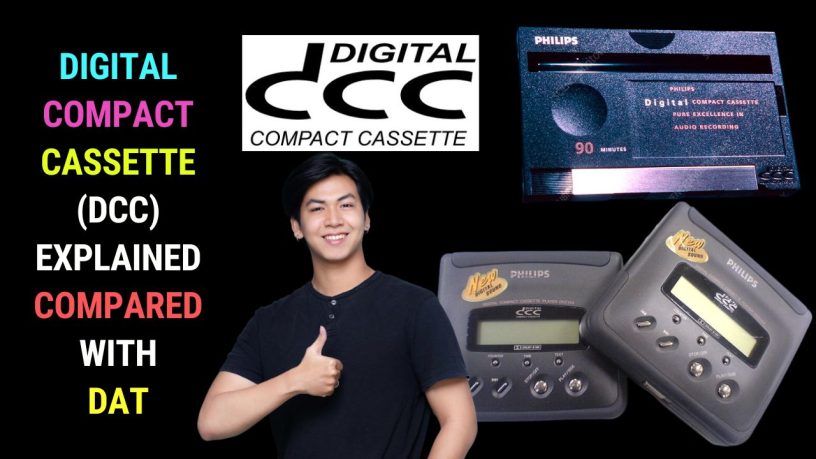Last updated on January 23rd, 2024 at 02:17 am
The digital compact cassette (DCC) is an improved version of the analog compact audio cassette or what is known as the standard compact cassette.
It was positioned to rival the digital audio tape (DAT) and MiniDisc, promising near-CD sound quality.

The DCC has a similar size to the analog compact cassette that Philips released in 1963.

Both also share the same tape speed of 4.8cm/second.
To attract consumers to embrace the digital compact cassette, DCC players were designed to play back the standard compact cassette as well.
History
The DCC was developed by Philips and Matsushita.
They announced the magnetic tape format in 1991. Home DCC decks were released the following year.
Playback and Recording
As mentioned, DCC decks can play digital compact cassettes and record on them.
However, they can only play standard compact cassettes but not record on them.
DCC vs DAT
The digital compact cassette offered digital audio like the digital audio tape (DAT).
Still, there are differences between them, chiefly the recording method employed.
DCC works on the stationary digital audio tape (S-DAT) principle.
DAT working on the rotary digital audio tape (R-DAT) principle.
The rotary principle is used in VCRs. In this instance, the tape is moved past a spinning magnetic head,
With the stationary principle, the head doesn’t move. The tape is moved back and forth.
The recording head is also capable of reading multiple tracks.
The DAT did not catch on with consumers. Most still preferred the standard audio cassette. And DAT players didn’t support the standard analog audio cassette.
That was why the digital compact cassette was introduced so that they get to enjoy analog and digital music on the same equipment.
Tape Size and Look
The DCC is larger than the DAT. The front side of the digital compact cassette has no holes. This allows for album cover graphics to be printed on it.

On the edge and back of the cassette there’s a sliding cover. It is very much like that on a 3.5-inch floppy disc.
It prevents dust from getting into the tape. The cover moves aside when you load the tape onto a DCC player.
The DCC comes in a box, but for shelving purposes, you won’t need it. The DCC has a flat surface and it’s easily stackable.
Recording
A standard digital compact cassette can hold 90 minutes of music. A DAT can hold 120 minutes of music.
A DCC player comes with a combihead. It allows for the playing and recording of digital audio tracks. It also supports the playing of analog tracks on standard compact cassettes.
Another highlight of the digital compact cassette technology is the recording speed.
DCC promises a recording speed 64 times that of a normal playing speed. These would allow for the recording of more tapes, bringing down production costs.
DATs, on the other hand, can’t be recorded at such high speeds.
Encoding
How is high-quality digital recording fitted into the same tape length as that of a standard compact cassette?
As many would know, analog audio recording requires less tape space.
To overcome the tape space problem the Precision Adaptive Sub-band Coding (PASC) encoding method is used.
PASC is part of MPEG-1 Audio Layer 1 (MP1). MP1 supports variable bitrates. However, PASC ‘s bitrate is fixed at 384kbps. DCC has the same sampling rate of 44.1kHz, the same as that of a CD.
PASC was originally developed for digital RM radio.

PASC works on the premise that the human ear can’t hear every sound out there. It analyzes sound patterns and eliminates data related to these inaudible sounds. This frees up space for the sounds that can be picked up by the human ear.
With this encoding method, about 75% of audio data encoded on a CD or DAT is eliminated without compromising much on sound quality.
For most folks, the sound quality of a DCC is close to that of a CD.
End of the Road
The DCC didn’t create an impact on the consumer market despite its ‘advanced’ technology.
The format was popular in the Netherlands. However, it didn’t make a dent among US consumers.
The digital compact cassette was discontinued in 1996.
However, they seem to be making a comeback, albeit on a smaller scale, as shown in the video below.



